
Patrick Hand Original Planter's Hat Menu: 1 2 3 4 Next>>
The Patrick Hand Original™ Planter's Hat, Page 3
Historic Precedents for Period Hats

Photo: Mission
A Smug Mission in the Patrick
Hand Original™ at Searle's in 2010
Having procured such an interesting hat made me smug, as you can see. OK, that's not actually true. From the beginning I was always curious why no one else had a hat quite like mine and it made me wonder - deep in the back of my mind - if the hat was actually accurate head gear for the golden age of piracy.
At some point when I was negotiating with Patrick to purchase the hat, I asked him about this and I believe he told me that it was in the style of a Caribbean planter's hat. (If he didn't tell me that, someone else did back then because began referring to it as a planter's hat in the very first Journal.) So I had always relied on that, even though I hadn't seen any period evidence of this being true.
As time went on and everyone associated me with the hat, I decided not to concern myself about this too much. There was always a bit of doubt in my mind until I privately asked UK historian Ed Fox if the hat was period correct and he assured me that it was. Even so, I still wanted proof.
One 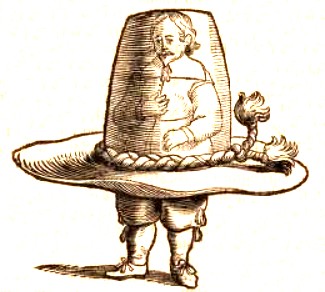
Image: Johann Daniel Major
A Man Engulfed in an Oversized Planter's Hat
From Vorstellung Etlicher Kunst (1674)
of the reasons I like researching golden age of piracy medicine is that there are many well-organized period primary sources for surgical procedures, sailors wounds and tools. Primary sources include unaltered books written by people from the period you are studying who are knowledgeable in the topic. Actual tools from the era are a primary source of information about the tools.
However, when you start wading into period fashions, particularly those worn by the lower classes (such as sailors), the primary source waters become muddied. There are not many (If there are any) extant
__frontispiece_1721.jpg)
NOT a Common Sailor, from
Britannia
americana of Beschryving
der Engelsche colonien in
West-Indien, frontispiece (1721)
examples of pirate clothing from the era, nor is their clothing discussed by knowledgeable period authors.
This leaves a lot of room for interpretation. It is easy to become bogged down in period clothing research, trying to find uncontrovertible proof that something is accurate. Confusion and insecurity can engulf you like an oversized planter's hat. For this reason, I tend to shy away from this subject.
You might guess that period artwork would be the saving grace here, but artwork is considered a secondary source, not a primary one. An artist interprets what he sees. Nevertheless, if you can find enough independent secondary sources - such as paintings showing an object - you can make a pretty good case that an object was most likely standard period clothing.
Still, you must be cautious, trying to understand the artist's intent and focus when it comes to fashion. As the author of the book The History of the Hat explains, "much of the evidence [of the style of clothing such as hats] is adduced from fashion-plates: that is to say, from the pictures of the richer classes, dressed in their richest garments."1 This is hardly the stuff of common sailors.
1 Micheal Harrison,The History of the Hat , p. 135;
Some Simple Sailor's Hat Styles From the Golden Age of Piracy
When I first started reenacting, I knew I would need a hat. Michael Harrison points out that during this time period a hat "was worn everywhere; or, rather, it is more correct to say that men hardly ever went uncovered."1 David Corner explains that "it is only in the current [20th] century that the hat has come to be considered a fashion accessory rather than an everyday article of attire."2
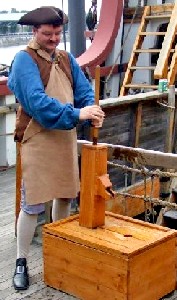
Image: Mission's Camera
Me In My Cocked Hat at
Columbus, Sept.. 2009
The only hat I felt certain would be appropriate for a pirate costume when I first started reenacting was a cocked hat - what we today call a tricorn. I touched on this earlier, but I make the distinction between cocked hats and tricorns because, such a hat would not be called a tricorn during the golden age of piracy. The first use of tricorn (Latin for "three horned") occurs in 18233, about 100 years after the end of the golden age of piracy.
Thus it should more appropriately be called a 'cocked' hat, with cocked being used as an adjective to describe the brim as having "an upward turn, tilt or angle."4 The only trouble with this description is that a hat can have one, two or more sides cocked. (I've not seen a hat with five sides cocked, but you could manage it if you wanted to.) So "cocked hat" tends to be overly broad when you are specifically referring to a tricorn.
As I got more involved in the world of reenacting, I started learning more about period clothing. (This despite my best efforts to avoid such information and let those who were interested and better read on the topic educate me while I focused on period surgical information.) From listening to other, well-read reenactors and doing a bit of reading myself, I have since learned that there were a variety of types of hats in use by sailors from the period.

Image: Mission
Thomas Grooms in
a Monmouth Cap
Columbus, Sept. 2010
Commenting on the subject of hats proper to the golden age of piracy, the Gentleman of Fortune website suggests two styles of knit hat that we will discuss briefly: the Monmouth cap and the thrum (or thrummed) cap.5 During the golden age of piracy, these two styles of hat were primarily confined to the fashions of the lower classes of society (like the common sailor). Both are borrowed from previous periods.
Michael Harrison explains that the Monmouth cap is derived from a Greek hat called a pileus. It was given the name Monmouth in Elizabeth the 1st's reign in the late 14th century. "It was worn by sailors, soldiers and Welshmen: but not more in this [Elizabeth's] reign than in previous reigns. It simply happens that it is noticed in this reign of notable observers, and is given a Welsh, rather than a Greek or Latin name."6
The Monmouth cap seems a practical one for a sailor, being less likely to blow off in the wind than a brimmed hat and it would also be a warm head-covering in the wind at sea. It may have been more favored by the Dutch than English during period, however. In the second volume of Daniel Defoe's Tour through the Whole Island of Great Britain (first published in 1725) Defoe notes that one of the "especial manufactures carried on in this country [Wales]... [are] Monmouth cups sold chiefly to the Dutch seamen, and made only at Beawdly."7
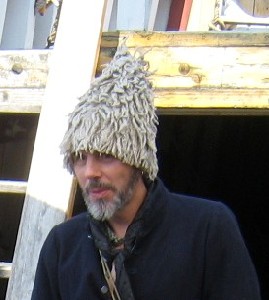
Image: Mission
Ivan Henry in a Thrum Hat at
Columbus
Santa Maria Pirate Weekend, May, 2012
The thrum hat also saw a resurgence of interest among the fashionable during the time of Elizabeth, although it is much, much older. Harrison explains that such a hat was found preserved in the
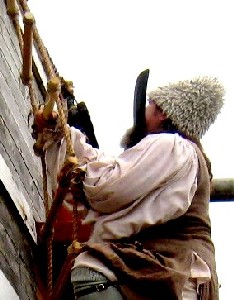
Image: Mission
M.A. d'Dogge in Thrum Hat at
Columbus, May, 2011
bogs of Jutland.8
'Thrumming', is method of weaving that gives the cloth a nap or pile. The term first appeared in the 14th century.9
Harrison reveals that "thrummed hats enjoyed a general vogue from the 1560s, until the generality of the vogue confined the wearing of thrummed hats to the less fashionable, the Smart Set adopting Spanish felts as the 16th century drew to a close."10 Thrum hats intuitively seem a less likely choice of headgear for a sailor in warm climes such as the Caribbean, although they are again closer fitted to the head and so more likely to stay on at sea.
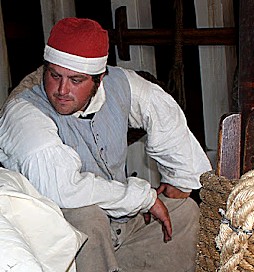
Image: DB Couper
Stephen Priddy in a Red Cap at
Columbus
Santa Maria Pirate Weekend, May, 2012
Not to be left out are simple caps. In the 1706 Admiralty Slops contract for the royal navy, the order called for: "Leather Capps faced with Red Cotton, and lined with Black Linnen... [and] Small Leather Capps stich’d with white Thread"11. From these simple descriptions,
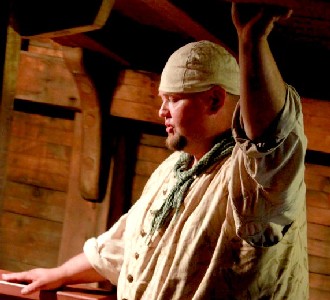
Image: Dolphin Dani
Carl Coco in a Cloth Cap,
Columbus, May, 2012
it is impossible to say what form the hat took, although something close to the head would again seem to be apt to the sailor's work. If so, these may have been akin to the skull cap which dates back a thousand years and more before the age of the pirates.
As Harrison comments, there are certain caps and hats such as these last, "which fall into no definable class; hats which are so 'basic' that one meets them on a Greek vase, or in a Winchester manuscript or on an Elizabethan tapestry. These are the immortals among hats. One sees them, and yet never sees them in shops. But they are here, in Elizabeth I's reign, just as they were in all previous times, and have been since."12 No doubt they were found at sea as well, there to confound the modern, proof-seeking reenactor.
1 Micheal Harrison,The History of the Hat , p. 121; 2 David Corner, "The Tyranny of Fashion: The Case of the Felt-Hatting Trade in the Late Seventeenth and Eighteenth Centuries", Textile History, Vol. 22, p 153; 3 "tricorn",Merriiam-Webster.com ,gathered 6/16/14; 4 "cock", wiktionary.com, gathered 6/16/14; 5 Pirate Living History 1680 - 1725: The Sailor's / Pirate's Hat, gentlemanoffortune.com, gathered 6/16/14; 6 Harrison, p. 101; 7 Daniel Defoe, A tour through the whole island of Great Britain, Volume 2, Letter 6; 8 Harrison, p. 104; 9 "thrum",Merriiam-Webster.com ,gathered 6/17/14; 10 Harrison, p. 104; 11 Admiralty Slop Contract, PRO Admirarly, Secretary, Orders and Instructions, July 12, 1706; 12 Harrison, p. 114;
Broad-Brimmed Hats
Hats with
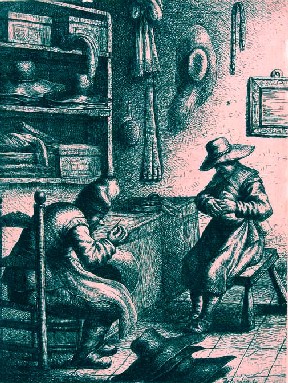
Artist: J. G. van Vliet
A Hatter's Shop Showing Broad Brims (1635)
large, stiff brims like the Patrick Hand Original™ Planter's Hat and those we associate with the pilgrims today, came into their fashionable own in the 17th century. Like most hats, they were called by various names such as capotain,
capatain or copotain1 as well as "Sugar Loaves or Steeples ...which have acquired immortality as the prototype American Pilgrim."2
The point to bear in mind about the hat fashions for the whole of Europe in the early 17th century is that, whether or not the crown of the hat was tall or shallow, the brim was large. This rim was to vary in width from generation to generation, but not until the end of the 18th century was the brim of any fashionable hat to revert to the small dimensions that it had attained in Elizabeth's time.3
Keep in mind that the above quote refers to fashionable hats, which are not necessarily the same as those that would have been used by sailors and pirates. However, there is evidence of their being in use by sailors just before and at the beginning of the golden age of the pirates.
A hat very much like the Patrick Hand Hat was found preserved in the mud when the sunken royal
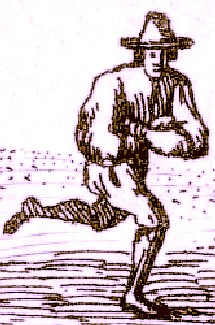
Detail from Zeer aanmerkelijke reysen
gedaan door Jan Erasmus Reining
meest
in de West Indien,
by Dionysius van de Sterre (1691)
Swedish ship Kronen was recovered. (The image is copyrighted, so you'll have to visit their website by following this link to see it.) The Kronen sank off the eastern coast of the Baltic island of Öland in June of 1676, right before the beginning of the golden age of piracy, so it dates the hat to near-period.
Other, early golden age of piracy period images shows pirates and sailors wearing brimmed felt hats like the capotain (such as the one seen here at left), suggesting that they were still in use amongst the sailors.
Such a hat would be an unusual one for a sailor to adopt, particularly at sea, given its potential for being blown off. Madeline Ginsburg explains that the hat began falling out of fashion in the beginning of the 17th century. "As early as 1616, Bowler had noted in The Artificial Changling [Anthropometamorphosis: Man Transform’d: or, the Artificiall Changling by John Bulwer]: 'Every puff of wind deprived us of the hat, requiring the employment of one hand to keep them on.'"4
Even so, they continued to be in use in the early part of the golden age of piracy as has been noted. In his examination of hat fashions, John Repton explains that "broad-brimmed hat surrounded with feathers placed round the rim prevailed in the reign of Charles II [1660-1685], and continued during great part of that of William III [1689-1702]."5 As a result of this research, I was comfortable that my hat was period accurate in style, just as Ed Fox had said. (I should never have even questioned this, but...you know.)
More interesting that proving the Patrick Hand Hat to be accurate to period was what I found out in the process of research about the seemingly ubiquitous cocked hat or tricorn at sea.
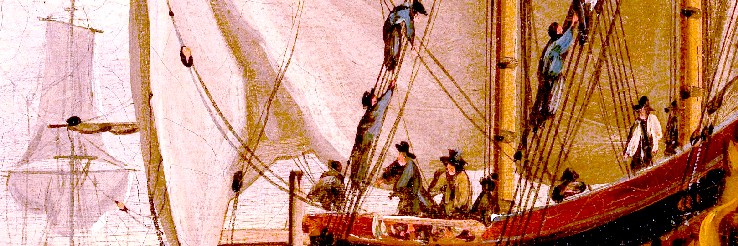 Artist: Peter Monamy - An Assortment of Large, Straight Hat Brims At Sea, Detail from Shipping in a Calm (1710-1725) |
1 Capotain hat, wikidpedia.com, gathered 6/17/14; 2 Madeline Ginsburg, The Hat Trends and Traditions, p. 45; 3 Micheal Harrison,The History of the Hat , p. 118; 4 Ginsburg, p. 46; 5 John Adey Repton, "Observations on the various Fashions of Hats", Archaeologia: or, Miscellaneous Tracts Relating to Antiquity. Vol. 24, p. 185

